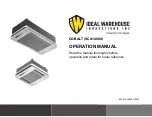
50
immediately, before leaving the site remember to:
-
seal the ends of the piping,
-
Ask the person in charge of the site to make sure that
the piping does not get squashed, bent or damaged
in any way.
g) The piping and the appliances (internal and external
units) are connected by means of binders. After the
piping has been cut and the nut which is found on the
connection has been inserted onto the piping (fig. 15),
the piping must be binded in accordance with the norms.
h) In order to tighten each joint it is necessary to:
-
grease the thread with refrigeration oil (do not use
other types of oil),
-
close the joint initially by hand,
-
tighten the joint with a dynamometrically calibrated
spanner with the following torque values:
-
14“ 18 Nx m (1,4“ 1,8 kgxm) for line attachments from
6,4“ 6 mm.
-
33“ 40 Nx m (3,3“ 4,0 kgxm) for line attachments from
9,5“ 10 mm.
-
50“ 60 Nx m (5,0“ 6,0 kgxm) for line attachments from
12,7“ 12 mm.
IMPORTANT: To avoid deforming the internal unitis
attachments when tightening, hold the welded part of the
joint with a spanner and tighten the other part with the
dynamometric spanner.
i ) Once the attachments have been tightened, the lineis
seal must be tested. In order to test the seal a cylinder
of anhydrous nitrogen is connected to the external unitis
gas pipe service connection (fig. 16) (after having
unscrewed the cap) (it is connected to the service
connections in the case of the Multisplit external units)
by means of a flexible with a 1/4" attachment and a
pressure reducer.
Open the cylinder and the pressure reducer until the
pressure in the circuit reaches 3 bars and then close the
cylinder. If the pressure does not descend after 3 minutes,
this means that there are no major leaks and the pressure
can be raised to 15 bars. After the cylinder is closed, the
pressure must remain constant for another 3 minutes. In
any case, to be completely sure it is advisable to apply
a solution of soap suds and check that bubbles do not
formed in the solution. If the pressure descends and the
solution test gives no results, insert some R410A into the
circuit and identify the leakage by means of a leak finder.
Since there should be no weldings in the system, the
leaks are nearly always found around the joints. Elimina-
te all gas leaks by tightening or repairing the joints and
repeat the seal test. Once the operation has been
concluded, reassemble the caps, checking carefully that
they have been closed properly.
IMPORTANT: In the case of Multisplit this operation must
be carried out on all the connections one after the other. The
search for gas leaks must be carried out each time on the
circuit which depends on the connection in question.
j)
Once the seal test has been passed, every trace of air,
nitrogen and humidity must be completely extracted
from the circuit. Lower the pressure within the circuit by
means of a vacuum pump until the pressure reaches an
absolute value equal to 50 Pa and, leaving the pump
Fig. 15
Fig. 16
1 CUT THE PIPE WITH A
WHEEL TYPE PIPE CUTTER
PERPENDICULAR CUT
2 DEBURR
PREVENT
CHIPS FALLING
INSIDE THE
PIPE
4 THE END OF THE PIPE MUST
PROTRUDE BY 0.5 mm
3 INSERT THE NUT IN THE
PIPE
6 THE FLARE MUST BE
CIRCULAR
SERVICE FITTING AND
PIPE FITTING
TAP MECHANISM
SERVICE FITTING
















































